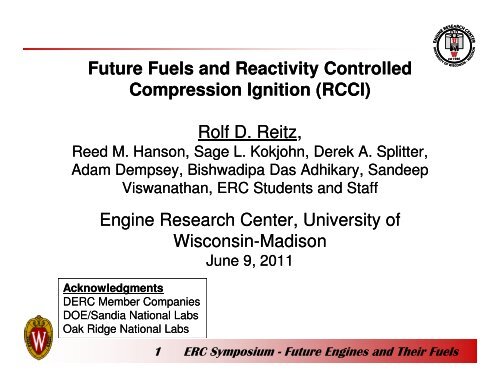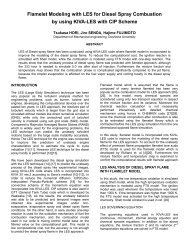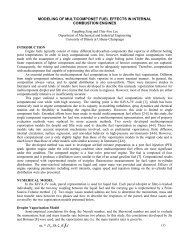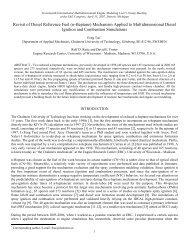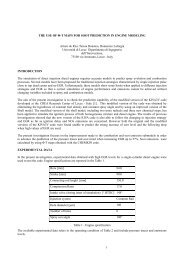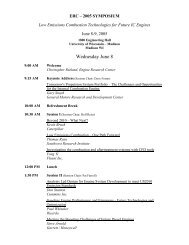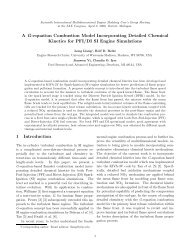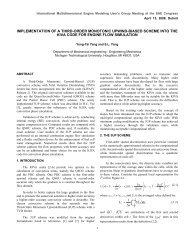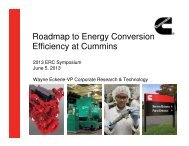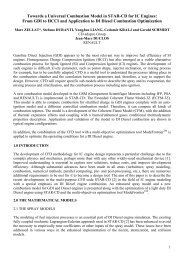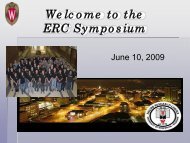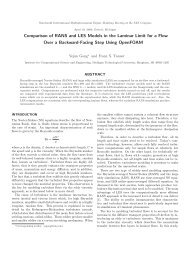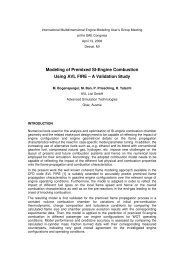Future Fuels and Reactivity Controlled Compression Ignition (RCCI ...
Future Fuels and Reactivity Controlled Compression Ignition (RCCI ...
Future Fuels and Reactivity Controlled Compression Ignition (RCCI ...
Create successful ePaper yourself
Turn your PDF publications into a flip-book with our unique Google optimized e-Paper software.
<strong>Future</strong> <strong>Fuels</strong> <strong>and</strong> <strong>Reactivity</strong> <strong>Controlled</strong><br />
<strong>Compression</strong> <strong>Ignition</strong> (<strong>RCCI</strong>)<br />
Rolf D. Reitz,<br />
Reed M. Hanson, Sage L. Kokjohn, Derek A. Splitter,<br />
Adam Dempsey, Bishwadipa Das Adhikary, S<strong>and</strong>eep<br />
Viswanathan, ERC Students <strong>and</strong> Staff<br />
Engine Research Center, University of<br />
Wisconsin-Madison<br />
Acknowledgments<br />
DERC Member Companies<br />
DOE/S<strong>and</strong>ia National Labs<br />
Oak Ridge National Labs<br />
June 9, 2011<br />
1 ERC Symposium - <strong>Future</strong> Engines <strong>and</strong> Their <strong>Fuels</strong>
Outline<br />
• <strong>RCCI</strong> combustion background<br />
• Experimental engines<br />
• Modeling <strong>and</strong> experimental results<br />
• Comparison of <strong>RCCI</strong> <strong>and</strong> conventional diesel<br />
• Use of renewable fuels – hydrated ethanol/diesel<br />
• Conclusions<br />
2 ERC Symposium - <strong>Future</strong> Engines <strong>and</strong> Their <strong>Fuels</strong>
IC engine combustion regimes<br />
• Gasoline engine spark-ignition with flame propagation:<br />
High turbulence for high flame speed heat losses, NOx <strong>and</strong> UHC/CO<br />
knock (CR, fuels), throttling losses low thermal efficiency TE ~25%<br />
• Diesel engine with spray (diffusion) combustion:<br />
Rich mixtures (soot), high temperatures (NOx) higher TE ~45%<br />
• H/Premixed Charge <strong>Compression</strong> <strong>Ignition</strong> – LTC, chemistry controlled:<br />
Sensitive to fuel, poor combustion/load control, low NOx-soot TE ~50%<br />
spark-ignition<br />
diesel<br />
H/PCCI<br />
3 ERC Symposium - <strong>Future</strong> Engines <strong>and</strong> Their <strong>Fuels</strong>
Dual fuel <strong>Reactivity</strong> <strong>Controlled</strong> <strong>Compression</strong> <strong>Ignition</strong><br />
• Addition of second fuel allows<br />
significant control over autoignition<br />
characteristics<br />
• Optimized stratification of fuel<br />
reactivity allows control of<br />
combustion duration<br />
2˚<br />
Single injection SOI = -55 o<br />
12% direct injected n-heptane, PRF=0<br />
88% premixed iso-octane, PRF=100<br />
8˚<br />
IMEP=5.5 bar, 2300 rev/min<br />
4 ERC Symposium - <strong>Future</strong> Engines <strong>and</strong> Their <strong>Fuels</strong>
<strong>RCCI</strong> combustion – Offers transient control<br />
• Heat release occurs in 3 stages (SAE 2010-01-0345)<br />
– Cool flame reactions result from n-heptane (diesel) injection<br />
– First energy release occurs where both fuels are mixed<br />
– Final energy release occurs where lower reactivity fuel is located<br />
• Changing fuel ratios changes relative magnitudes of stages<br />
• Fueling ratio provides “next cycle” CA50 transient control<br />
AHRR [J/ o ]<br />
200<br />
150<br />
100<br />
50<br />
0<br />
Cool Flame<br />
Primarly<br />
n-heptane<br />
PRF Burn<br />
n-heptane<br />
+ entrained<br />
iso-octane<br />
Iso-octane Burn<br />
-20 -10 0 10 20<br />
Crank [ o ATDC]<br />
Primarly<br />
iso-octane<br />
Delivery Ratio [% iso-octane]<br />
95<br />
90<br />
85<br />
80<br />
75<br />
70<br />
65<br />
60<br />
55<br />
♎ ♓␛♋♓<br />
♎❄ CA50=2 ˚ ATDC<br />
♍<br />
<br />
80 90 100 110 120 130 140 150 160 170<br />
Intake Temperature [ o C]<br />
<strong>RCCI</strong><br />
SOI = -50 ATDC<br />
5 ERC Symposium - <strong>Future</strong> Engines <strong>and</strong> Their <strong>Fuels</strong><br />
5
Multiple injections for optimized <strong>RCCI</strong><br />
Port injected gasoline<br />
Direct injected diesel<br />
Gasoline<br />
Injection<br />
Signal<br />
Squish<br />
Conditioning<br />
-80 to -50 -45 to -30<br />
Crank Angle (deg. ATDC)<br />
KIVA plus Genetic Algorithms used<br />
to optimize multiple injection strategy<br />
<strong>Ignition</strong><br />
Source<br />
Gasoline<br />
Diesel<br />
Diesel<br />
6 ERC Symposium - <strong>Future</strong> Engines <strong>and</strong> Their <strong>Fuels</strong>
<strong>RCCI</strong> high speed<br />
combustion<br />
luminosity<br />
imaging<br />
Load: 4.2 bar IMEP<br />
Kokjohn, S.<br />
GDI SOI: -240°ATDC<br />
Musculus, M.P.B<br />
Speed: 1200 rpm CR SOI: -57°/-37°ATDC<br />
Reitz, R.D.,<br />
Intake Temperature: 90°C<br />
ILASS-2011<br />
Equivalence ratio: 0.42<br />
Intake Pressure: 1.1 bar abs. Iso-octane mass %: 64<br />
Bowl window<br />
Squish (upper) window<br />
7 ERC Symposium - <strong>Future</strong> Engines <strong>and</strong> Their <strong>Fuels</strong>
Heavy- <strong>and</strong> light-duty ERC experimental engines<br />
Engine Heavy Duty Light Duty<br />
Engine CAT SCOTE GM 1.9 L<br />
Displ. (L/cyl) 2.44 0.477<br />
Bore (cm) 13.72 8.2<br />
Stroke (cm) 16.51 9.04<br />
Squish (cm) 0.157 0.133<br />
CR 16.1:1 15.2:1<br />
Swirl ratio 0.7 2.2<br />
IVC (°ATDC) -85 <strong>and</strong> -143 -132<br />
EVO(°ATDC) 130 112<br />
Injector type<br />
Common rail<br />
Nozzle holes 6 8<br />
Hole size (µm) 250 128<br />
Engine size scaling<br />
Staples et al.<br />
SAE 2009-01-1124<br />
HD<br />
LD<br />
8 ERC Symposium - <strong>Future</strong> Engines <strong>and</strong> Their <strong>Fuels</strong>
<strong>RCCI</strong> experimental validation<br />
- HD Caterpillar SCOTE<br />
IMEP (bar) 9<br />
Speed (rpm) 1300<br />
EGR (%) 43<br />
Equivalence ratio (-) 0.5<br />
Intake Temp. (°C) 32<br />
Intake pressure (bar) 1.74<br />
Gasoline (% mass) 76 82 89<br />
Diesel inject press. (bar) 800<br />
SOI1 (°ATDC) -58<br />
•<br />
SOI2 (°ATDC) -37<br />
Fract. diesel in 1 st pulse 0.62<br />
IVC (ºBTDC)/Comp ratio 143/16<br />
Pressure [MPa]<br />
10<br />
8<br />
6<br />
4<br />
2<br />
Effect of gasoline percentage<br />
14 Experiment<br />
Simulation<br />
12<br />
Neat<br />
Diesel Fuel<br />
76%<br />
82%<br />
89%<br />
89%<br />
Gasoline<br />
Neat<br />
Gasoline<br />
0<br />
0<br />
-30 -20 -10 0 10 20 30<br />
Crank [°ATDC]<br />
* Hanson et al.<br />
SAE 2010-01-0864<br />
1400<br />
1200<br />
1000<br />
800<br />
600<br />
400<br />
200<br />
Apparent Heat Release Rate [J/°]<br />
• Computer modeling predictions confirmed<br />
• Combustion timing <strong>and</strong> Pressure Rise Rate control with diesel/gasoline ratio<br />
• Dual-fuel can be used to extend load limits of either pure diesel or gasoline<br />
9 ERC Symposium - <strong>Future</strong> Engines <strong>and</strong> Their <strong>Fuels</strong>
<strong>RCCI</strong> – high efficiency, low emissions, fuel flexibility<br />
• Indicated efficiencies of 59%<br />
achieved with E85/diesel<br />
• Emissions met in-cylinder,<br />
without need for after-treatment<br />
• Considerable fuel flexibility,<br />
including ‘single’ fuel operation<br />
• Diesel can be replaced with<br />
Comparison of conv. diesel <strong>and</strong> <strong>RCCI</strong> - KIVA CFD<br />
Pressure [bar]<br />
Average Temperature [K]<br />
140<br />
120<br />
100<br />
80<br />
60<br />
40<br />
20<br />
<strong>RCCI</strong><br />
Diesel<br />
-20<br />
-16<br />
-12<br />
TDC<br />
0<br />
0<br />
-20 -15 -10 -5 0 5 10 15 20 25 30<br />
2700<br />
2400<br />
2100<br />
1800<br />
1500<br />
1200<br />
900<br />
9 bar IMEP,<br />
1300 rpm,<br />
41% EGR<br />
-20<br />
-8<br />
-4<br />
Crank [°ATDC]<br />
-16<br />
-12<br />
+4<br />
Diesel SOI<br />
Retard<br />
600<br />
-20 -15 -10 -5 0 5 10 15 20 25 30<br />
-8<br />
-4<br />
Crank [°ATDC]<br />
TDC<br />
+4<br />
<strong>RCCI</strong><br />
Diesel<br />
1500<br />
1200<br />
900<br />
600<br />
300<br />
Heat Release Rate [J/°]<br />
Peak Temperature [K]<br />
• Sharp end-of-combustion<br />
• Peak temperatures reduced<br />
significantly compared to<br />
conventional diesel combustion<br />
• Difference between peak <strong>and</strong><br />
average temperatures very small<br />
for <strong>RCCI</strong> combustion<br />
2700<br />
2400<br />
2100<br />
1800<br />
1500<br />
1200<br />
– Well mixed combustion event<br />
-20<br />
-16<br />
-12<br />
900<br />
<strong>RCCI</strong><br />
Diesel<br />
600<br />
-20 -15 -10 -5 0 5 10 15 20 25 30<br />
11 ERC Symposium - <strong>Future</strong> Engines <strong>and</strong> Their <strong>Fuels</strong><br />
-8<br />
-4<br />
TDC<br />
+4<br />
Crank [°ATDC]
Comparison of conv. diesel <strong>and</strong> <strong>RCCI</strong> combustion<br />
• High temperature in conventional diesel next to piston bowl surface<br />
• Highest temperature for <strong>RCCI</strong> in center of chamber (adiabatic core)<br />
• Region near liner has similar temperatures<br />
– heat transfer differences are at piston bowl surface<br />
Temperature contours near CA50, Crank = 6.1 deg ATDC<br />
12 ERC Symposium - <strong>Future</strong> Engines <strong>and</strong> Their <strong>Fuels</strong>
Comparison of conv. diesel <strong>and</strong> <strong>RCCI</strong> - KIVA CFD<br />
Gross Indicated Efficiency [%]<br />
57<br />
54<br />
51<br />
48<br />
45<br />
42<br />
39<br />
SOI -20° ATDC<br />
<strong>RCCI</strong><br />
7% of<br />
fuel energy<br />
High EGR Diesel Pinj 800 bar<br />
High EGR Diesel Pinj 1800 bar<br />
<strong>RCCI</strong> Combustion<br />
-10 -5 0 5 10 15 20 25<br />
CA50 [°ATDC]<br />
<strong>RCCI</strong>:<br />
- Similar pressure rise rates<br />
- Significantly lower NOx <strong>and</strong> soot<br />
- 16% higher thermal efficiency<br />
- Reduced heat losses (~50%)<br />
- Improved end-of-combustion phasing<br />
Fuel Energy [%]<br />
<strong>RCCI</strong><br />
(800 bar)<br />
High-EGR<br />
Diesel<br />
(1800 bar)<br />
Ringing (MW/m 2 ) 3.8 2.8<br />
Max PRR (bar/deg) 10.3 8.9<br />
Gross Indicate TE (%) 54.3 48.5<br />
Combustion Loss (%) 1.3 0.7<br />
ISNOx (g/kW-hr) 0.006 0.97<br />
ISsoot (g/kW-hr) 0.01 0.1<br />
100<br />
90<br />
80<br />
31.6<br />
41.5<br />
33.4 38.1<br />
70<br />
60 19.2 10.9<br />
50<br />
40<br />
54.3 61.9<br />
30<br />
57.9<br />
Comb. Loss<br />
48.5<br />
Exhaust<br />
20<br />
Heat Loss<br />
10<br />
GIE<br />
0<br />
With HT Adiabatic With HT Adiabatic<br />
SOI -12 o 13 ERC Symposium - <strong>Future</strong> Engines <strong>and</strong> Their <strong>Fuels</strong><br />
High-EGR Diesel<br />
<strong>RCCI</strong>
Collaboration with Oak Ridge - Parks et al. DOE ACE031-2011<br />
14 ERC Symposium - <strong>Future</strong> Engines <strong>and</strong> Their <strong>Fuels</strong>
<strong>RCCI</strong> low emissions – HC reduced with DOC<br />
15 ERC Symposium - <strong>Future</strong> Engines <strong>and</strong> Their <strong>Fuels</strong>
Fuel flexibility <strong>and</strong> the future – renewable fuels<br />
“The fuel of the future is going to come from fruit like that sumac out by the<br />
road, or from apples, weeds, sawdust – almost anything.<br />
There is fuel in every bit of vegetable matter that can be fermented.”<br />
– Henry Ford, 1925<br />
http://www.energyfuturecoalition.org/biofuels/fact_ethanol.htm<br />
37% of fuel energy consumed<br />
in distillation-dehydration.<br />
Use of hydrated EtOH can give<br />
significant net energy gain<br />
16 ERC Symposium - <strong>Future</strong> Engines <strong>and</strong> Their <strong>Fuels</strong><br />
16
Can “Wet” ethanol be used with <strong>RCCI</strong>?<br />
• Cannot be used with SI engines due to lower flame speeds, misfire,<br />
condensation problems, phase separation of water with EtOH-gasoline<br />
• Cannot be used with diesel engines due to high EtOH octane number<br />
• Has been proposed for use in HCCI engines – Berkeley, LLNL*<br />
High heat of vaporization:<br />
Gasoline = 308 kJ/kg<br />
EtOH = 924 kJ/kg<br />
H 2 O = 2400 kJ/kg<br />
GT-Power predicted<br />
IVC temperature<br />
- port injected wet<br />
ethanol/gasoline<br />
7<br />
o<br />
9 bar IMEP<br />
20<br />
o<br />
52 o<br />
compression<br />
*Flowers et al. “Improving Ethanol<br />
Life Cycle Energy Efficiency by Direct<br />
Utilization of Wet Ethanol in HCCI<br />
Engines, SAE 2007-01-1867<br />
17 ERC Symposium - <strong>Future</strong> Engines <strong>and</strong> Their <strong>Fuels</strong>
Can “Wet” ethanol be used with <strong>RCCI</strong>?<br />
CHEMKIN HCCI simulations - mixtures of hydrated ethanol <strong>and</strong> 20% diesel<br />
5 bar 9 bar<br />
• Use constant intake<br />
temperature<br />
• Water mainly effects<br />
intake temperature<br />
13.5 bar 16 bar<br />
Dempsey et al. ASME 2011<br />
18 ERC Symposium - <strong>Future</strong> Engines <strong>and</strong> Their <strong>Fuels</strong>
Fuel reactivity stratification - EtOH/H<br />
2 O & DI diesel<br />
KIVA CFD simulation<br />
1300 rpm, 9 bar IMEP<br />
Fuel reactivity stratification with<br />
premixed Wet ethanol <strong>and</strong> DI diesel<br />
Wet ethanol gives large<br />
reactivity gradients<br />
reduces pressure rise rate<br />
19 ERC Symposium - <strong>Future</strong> Engines <strong>and</strong> Their <strong>Fuels</strong>
Cylinder pressure <strong>and</strong> heat release with EtOH/H<br />
2 O<br />
5 bar IMEP<br />
9 bar IMEP<br />
13.5 bar 16 bar<br />
20 ERC Symposium - <strong>Future</strong> Engines <strong>and</strong> Their <strong>Fuels</strong>
Thermal efficiency &emissions with 70% EtOH/H<br />
2 O<br />
Diesel amount varied to control combustion phasing with 0% EGR<br />
21 ERC Symposium - <strong>Future</strong> Engines <strong>and</strong> Their <strong>Fuels</strong><br />
21
Summary <strong>and</strong> conclusions<br />
<strong>RCCI</strong> offers practical low-cost pathway to >15% improved diesel<br />
engine fuel efficiency (lower CO 2 ) + meet emission m<strong>and</strong>ates in-cylinder<br />
Inconvenience of two fuels already accepted by diesel industry (diesel/urea)<br />
<strong>RCCI</strong> is cost effective:<br />
- low cost port-injected less reactive fuel (e.g., gasoline, E85, “wet” EtOH, C/LNG)<br />
with optimized* low pressure DI of more-reactive fuel (e.g., diesel/additized gas)<br />
- Diesel or GDI (w/spark plug) operation can be retained (limp home).<br />
<strong>RCCI</strong> offers great fuel flexibility <strong>and</strong> transient response:<br />
- proportions of low <strong>and</strong> high reactivity fuels can be changed dynamically, based<br />
on fuels used with same/next-cycle combustion feedback control<br />
<strong>RCCI</strong> can be used with alternative fuels, including hydrated “wet” ethanol<br />
- significantly shifts net energy gain of bio-ethanol fuel production<br />
(75% of total distillation energy to remove last 20% of water in EtOH/H 2 O)<br />
- intake charge cooled significantly less charge air cooling with boosting<br />
- combustion is retarded due to water addition less EGR required<br />
- with a single grade of hydrated ethanol (70% ethanol-in-water) <strong>and</strong> 0% EGR,<br />
low NOx <strong>and</strong> soot predicted from 5 to 16 bar IMEP with peak GTE > 55%<br />
* WARF Patents pending<br />
22 ERC Symposium - <strong>Future</strong> Engines <strong>and</strong> Their <strong>Fuels</strong>
<strong>Future</strong> Engines <strong>and</strong> their <strong>Fuels</strong> in Sweden – today!<br />
http://www.greencarcongress.com/2011/05/volvo-20110531.html<br />
23 ERC Symposium - <strong>Future</strong> Engines <strong>and</strong> Their <strong>Fuels</strong>
Thank you for your attention!<br />
24 ERC Symposium - <strong>Future</strong> Engines <strong>and</strong> Their <strong>Fuels</strong>
Thermal efficiency &emissions with 70% EtOH/H<br />
2 O<br />
EGR varied to control combustion phasing with 20% diesel injection<br />
25 ERC Symposium - <strong>Future</strong> Engines <strong>and</strong> Their <strong>Fuels</strong><br />
25
<strong>RCCI</strong> particulate matter reduced by DOC<br />
26 ERC Symposium - <strong>Future</strong> Engines <strong>and</strong> Their <strong>Fuels</strong>
<strong>RCCI</strong> low particle number – by 2 orders of magnitude<br />
27 ERC Symposium - <strong>Future</strong> Engines <strong>and</strong> Their <strong>Fuels</strong>
<strong>RCCI</strong> – provides high efficiency, low emissions<br />
HD engine gasoline/diesel<br />
<strong>RCCI</strong> gives near zero NOx<br />
<strong>and</strong> soot <strong>and</strong> peak gross<br />
thermal efficiency of 56%<br />
Pressure [bar]<br />
AHRR [J/deg]<br />
140<br />
120<br />
100<br />
80<br />
60<br />
40<br />
20<br />
0<br />
Experiment = Solid<br />
Simulation = Dash<br />
800 4.6 bar<br />
700<br />
600<br />
500<br />
400<br />
5.9 bar<br />
9.3 bar<br />
11.6 bar<br />
14.6 bar<br />
300<br />
200<br />
100<br />
0<br />
-20 -15 -10 -5 0 5 10 15 20 25 30<br />
Crank [°ATDC]<br />
Kokjohn et al. IJER 2011<br />
Hanson et al. SAE 2010-01-0864<br />
Splitter et al. THIESEL 2010<br />
NOx<br />
[g/kW-hr]<br />
Soot<br />
[g/kW-hr]<br />
Gross Ind.<br />
Efficiency [%]<br />
Ringing Int.<br />
[MW/m 2 ]<br />
1300 rev/min<br />
0.3<br />
0.2<br />
0.1<br />
0.0<br />
0.02<br />
0.01<br />
0.00<br />
56<br />
54<br />
52<br />
50<br />
48<br />
4<br />
2<br />
0<br />
2010 EPA HD Limit<br />
2010 EPA HD Limit<br />
Experiment<br />
Simulation<br />
4 6 8 10 12 14 16<br />
IMEPg [bar]<br />
28 ERC Symposium - <strong>Future</strong> Engines <strong>and</strong> Their <strong>Fuels</strong>


